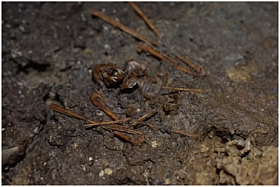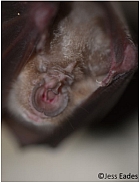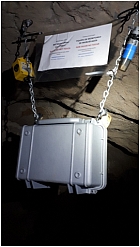MATIENZO CAVES PROJECT
Matienzo Bats in Caves Project
Jessica Eades
Many cavers involved in the expedition, actively looking for new cave entrances or exploring and extending known caves, have identified bats using the caves. Only a small proportion make specific note of seeing bats when preparing the written accounts of their explorations.
This project has been set up to record those sightings, promote and encourage all expedition team members to share any sightings and improve the science element of the expeditions in terms of bat distributions within the permit area. This will be undertaken through knowledge sharing to build foundation skills and further maintain strong bat researcher and caver relations.
The 'Matienzo Bats in Caves Project' was instigated in 2019 and comprises three main elements:
Citizen Science, Bats in the Valley and Cave Specific Research.
Citizen Science
Many expedition cavers notice roosting bats within the caves, but only a small proportion actively note these sightings in their accounts of cave exploration. This element of the project is designed to formally capture these incidental sightings of roosting bats during the exploration of new and known caves within the permit region.
A simple form, designed to allow swift input of findings, has been created. All cavers will now be able to record these sightings, allowing a simple distribution map of cave bat roosts within the permit region to be created and highlight any significant roosts. A handy guidance sheet (in preparation) accompanies the form providing help should people wish to provide more than basic information.

Bat identification posters will be available from Easter 2020 to help with visual identification, promote the project and encourage maximum engagement from the expedition team. Small sample pots are also available for expedition members to carry in their underground kit so, should they find bat droppings, samples may be taken which can then be later checked to ensure it is a bat dropping and then potentially sent for DNA analysis to confirm the species of bats and further populate distribution maps for the bat species in the area. The aim of this element of the project is to establish long term data gathering which can be used to further knowledge of how and where bats are using caves within the permit region, identify potential areas for further investigation, and allow knowledge sharing with local bat researchers within the Cantabrian region.
All expedition members can get involved in the project and, should they wish, advance over time in the level and complexity of the information they contribute. All bat sighting records should be an incidental result of the normal caving / exploration activities and the project does not promote spending significant periods of time viewing live bats in order to gather information. Any data gathered is useful!
This element focuses on which bat species may be encountered both above and below ground within the permit region. It also helps to identify which bat species are likely to be encountered underground, with the production of identification guides to assist expedition members with species identification and those who may wish to provide advanced notes. This information will be gathered using bat detectors to monitor and record bat echolocation calls. The recordings captured are then used to identify family and hopefully species of bats (as each bat species produces a different type of call). Driven or walked transects throughout the permit area will be undertaken with recordings geo-referenced for later mapping. Static monitoring can also be undertaken. In December 2019, a number of bat detectors were placed on the balconies of private residences through Matienzo village to monitor bat activity over a two week period. Information on Bats in the Valley will be summarized and updates posted online at appropriate times.
The Journal of Bat Research & Conservation released an article by Molleda et al (2018)1 which highlighted the species currently recorded within Cantabria. The table below is provided from that paper. Not all of these species may be encountered within the expedition permit area but, as there appears to be limited information for this area, information gathered from this project will be fed back to further knowledge of the species composition.
There are currently known to be a total of 25 bat species recorded within Cantabria. Within the UK there are 18 species of bat, 17 of which are known to be breeding. Those species that may be encountered within both the UK and Cantabria have been highlighted in bold in the table.
1 Molleda, R. and Fombellida, I. (2018) Contribución al conocimiento de la distribución y estatus de la fauna quiropterológica de la Comunidad Autónoma de Cantabria. Journal of Bat Research and Conservation. Volume 11(1) 2018.
http://secemu.org/wp-content/uploads/2018/09/Molleda_et_al_2018.pdf

Scientific Name |
Common Name |
Rhinolophus ferrumequinum |
Greater horseshoe bat |
Rhinolophus hipposideros |
Lesser horseshoe bat |
Rhinolophus euryale |
Mediterranean horseshoe bat |
Myotis myotis |
Greater mouse-eared bat* |
Myotis bechsteinii |
Bechstein's bat |
Myotis daubentonii |
Daubenton's bat |
Myotis escalerai |
Escalera's bat |
Myotis cf nattereri |
Natterer's bat |
Myotis emarginatus |
Geoffroy's bat |
Myotis alcathoe |
Alcathoe bat |
Myotis mystacinus |
Whiskered bat |
Pipistrellus pipistrellus |
Common pipistrelle |
Pipistrellus pygmaeus |
Soprano pipistrelle |
Pipistrellus kuhlii |
Kuhl's pipistrelle |
Pipistrellus nathusii |
Nathusius' pipistrelle |
Hypsugo savii |
Savi's pipistrelle |
Eptesicus serotinus |
Serotine bat |
Nyctalus leisleri |
Leisler's bat also known as Lesser noctule bat |
Nyctalus lasiopterus |
Greater noctule bat |
Nyctalus noctule |
Common noctule bat |
Barbastella barbastellus |
Western Barbastelle also known as Barbastelle bat |
Plecotus auritus |
Brown long-eared bat also known as Brown Big-eared bat |
Plecotus austriacus |
Grey long-eared bat also known as Grey Big-eared bat |
Miniopterus schreibersii |
Schreiber's bent-winged bat |
Tadarida teniotis |
European free-tailed bat |
* Within the UK, greater mouse-eared bat was discovered in 1958. Two hibernating colonies were found in the 1960s along the south coast of England, but the last record of a greater mouse-eared bat at the site was in 1988. In 1990, the species was officially declared extinct in the UK. In 2002, however, a juvenile male was discovered and has been recorded each year since hibernating. The bat has not been found when not hibernating.

This element focuses on gaining in-depth knowledge about how bats use a specific cave within the permit region. Research will be targeted at caves that have been identified as potentially supporting significant roosts in terms of species and/or number of bats. Research methods may vary on a cave by cave basis, with specific research not being undertaken every year perhaps.
Towards the end of July 2019, recording equipment was deployed within a single cave to begin 12 months of passive monitoring. The cave has been identified as having significant volumes of bat droppings which may indicate the presence of a significant cave roost. An old survey also hints that this roost may have been present for at least 30 years! Bat detectors have been located at key positions within the cave to monitor and record the acoustic echolocation sounds that the bats may make whilst traveling through the cave to the roost location(s). This research does not involve handling any bats, but merely listening for their calls. The recordings captured are used to identify the species of bats using the caves, the frequency of the recordings and establish if there are peak times when the bats roost within the cave.
Information gathered through the cave specific research will be published at the completion of each project, with summary updates posted at appropriate times.
